Champagne in the time of Corona. Virus, that is.

“Champagne makes you feel like it’s Sunday, and there are better days around the corner.” – Marlene Dietrich
By Panos Kakaviatos
27 April 2020
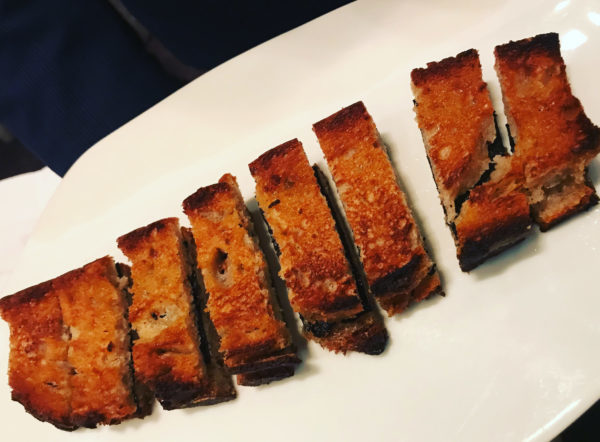
Truffle sandwiches Façon Rostang: worth the risk.
When I arrived the evening of 6 March, thanks to friend Claire Dawson, some dinner participants nervously shook hands. But any apprehensive air eroded as we enjoyed the fabulously simple mini truffle sandwiches, the signature aperitif of the restaurant made with butter and toast: “Façon Rostang.”
And the occasion, to mark the 20th anniversary of Champagne Gonet-Médeville was important enough to attract several top wine journalists based in Paris, including legendary French wine writer Michel Bettane.

Such a huge bottle brings out the craziest of expressions: with Julie Médeville and husband Xavier Gonet, just before dinner.
The name of the estate may remind readers of a well-known Graves property in Bordeaux: Château Respide-Médeville. Julie Médeville and her family own the Graves estate along with the celebrated Sauternes, Château Gilette. She co-founded the Champagne enterprise in 2000 with husband Xavier Gonet, who comes from the seventh generation of a family of growers in Mesnil-sur-Oger. Situated in Bisseuil, between Mareuil sur Ay and Bouzy, Gonet-Médeville has grown to include nearly 10 hectares of vines in eight villages: three Grands Crus (Le Mesnil sur Oger, Oger, and Ambonnay) and five Premiers Crus to produce about 80,000 bottles a year. The focus is to craft fine, small-production Champagnes, with no malolactic fermentation and minute dosages.
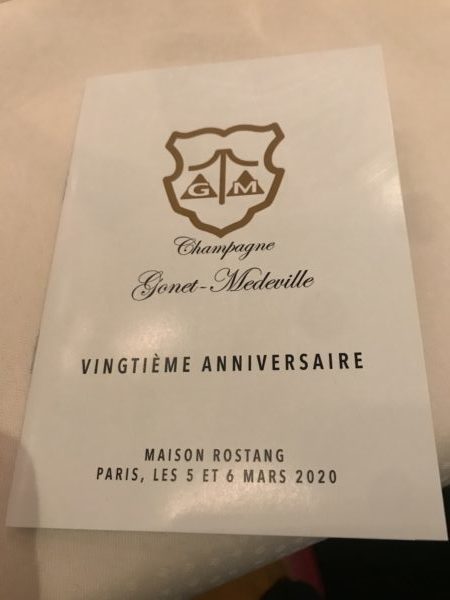
A final non social distancing invite, before COVID-19 set in.
Champagne, you say? Most think of famous brands, such as Veuve Clicquot and Moët Chandon, even if more than 100 Champagne houses exist, along with some 19,000 smaller vine-growing producers. This 20th anniversary dinner proved that Gonet-Médeville counts among the very best of the smaller growers, with some tiny production wines rivaling top brands in quality, and besting them in terms of price.
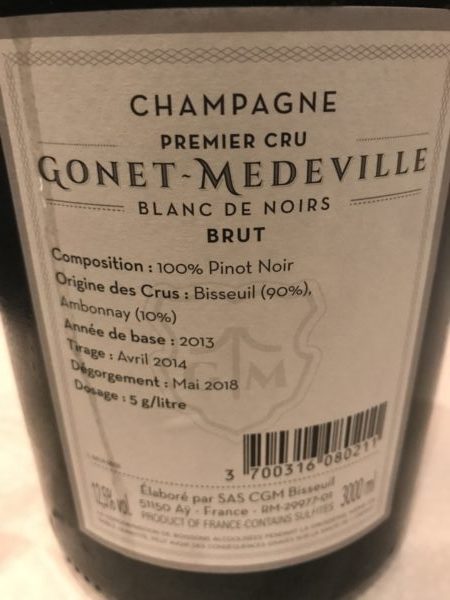
Nuanced and delicious non vintage Champagne for $50 retail: I am a buyer.
Champagne Gonet-Médeville’s Pinot Noir (Bisseuil and Ambonnay) and Chardonnay (Mesnil-Sur-Oger) have been grown organically since 2016, and each parcel is vinified separately in old oak barrels to emphasize individual terroirs. The couple has succeeded in exporting one-third of their production to the competitive U.S. market.
But I had discovered Gonet-Médeville only as recently as earlier this year (at the Ill Vino wine bar in Strasbourg), and was very impressed. So when Claire invited me to this Paris dinner, I jumped at the chance.
We started off with a classic: toasted bread with butter and truffle, paired with a fine Cuvée Tradition 1er Cru, blending 70% Chardonnay, 25% Pinot Noir and 5% Pinot Meunier from vines in Bisseuil, Le Mesnil-sur-Oger and Mareuil-sur-Aÿ. Aged four years in bottle, with a 2018 disgorgement date, the six grams of residual sugar provided richness. Served from a Jeroboam, the wine came across fresh. It costs in the mid $30 range in the U.S. with 30,000 bottles produced.
But the star of the two non-vintage Champagnes – and one I would encourage readers to purchase – is the Blanc de Noirs 1er Cru. The $50 price tag (also 30,000 bottles produced) is more than reasonable for the quality. This 100% Pinot Noir, served from Jeroboam and having aged four years in bottle and disgorged in 2018, was more pure, more precise and gorgeously brisk in aspect. The five grams of residual sugar conveyed opulence. This wine cut through the impeccably simple and famous (in Paris, at least) sandwich à la truffe.
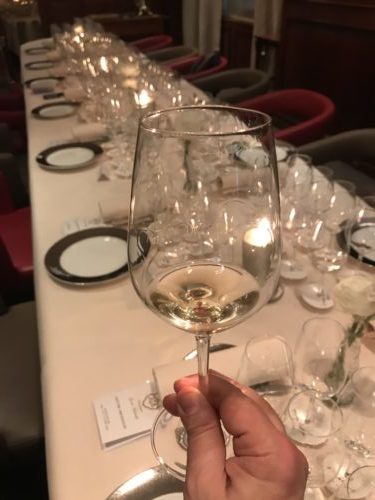
No flutes, no coupes: Serious Champagne is like fine Burgundy 😉
The next course of roasted frog legs and parsley was well matched by the opulent 2005 vintage Cuvée Théophile Grand Extra Brut. Aged in bottle for 13 years – it was disgorged only in December last year – the two grams of residual sugar were just enough because of the inherently ripe aspect of the vintage. A vinous Champagne that over-powered the frog legs. Blending 60% Chardonnay and 40% Pinot Noir sourced respectively from Le Mesnil-sur-Oger and Ambonnay, it retails for $125 with only 3,000 bottles produced.
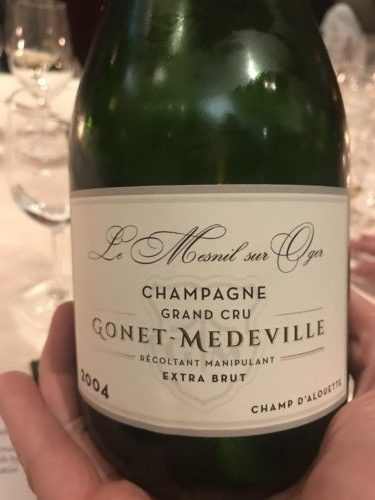
Just fabulous!
The next wines – which cost about $50 more – impressed me more as well: the Cuvée Louvière 2007 Grand Cru Extra Brut and the amazing Cuvée Champ d’Alouette 2004 Grand Cru Extra Brut. Both 100% Chardonnay from Le Mesnil-sur-Oger, with two grams of residual sugar, the former had been aged 11 years and disgorged in 2019, while the latter had been aged 12 years and disgorged in 2017. Paired with scallop and mushrooms, these two wines proved a dinner highlight. The Cuvée Louvière polished and refined in expression, very lemon lime and fresh, with much vivacity. The Champ d’Alouette, which I had tried previously in Strasbourg, France, see video below, came across just as vivacious and fresh, but more generous and opulent, along with underlying density and power. Both very serious and delicious bubblies fit for gastronomy.
Then we enjoyed two vintages coming from a parcel of just over 0.3 acres (12.93 ares), meaning just about 1,000 bottles produced each year. The Cuvée Grande Ruelle 2006 Grand Cru Extra Brut exuded much depth and focus and matched the Volaille de Bresse perfectly, and the truffle over accompanying pasta echoed some light evolution in the wine, especially found in the 2002, which we also enjoyed.
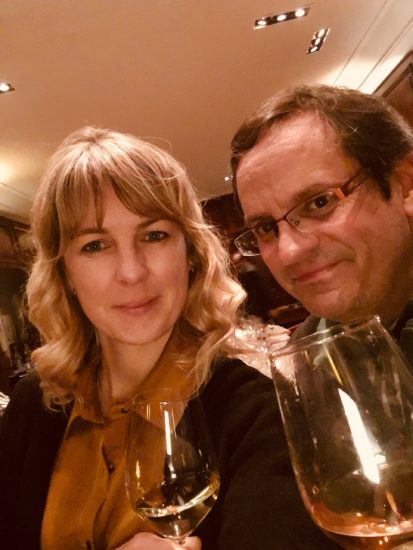
Many thanks to Claire Dawson for this invitation.
Dinner ended with some excellent pain perdu and coulis de pomme citronné dessert along with a wonderful Cuvée Théophille Rosé from the 2009 vintage. Such rich red berry fruit aspects combined with genuine vivacity – again but 2 grams of residual sugar. The eight years aging in bottle lend complexity. “I do not have enough in my cellar,” commented Michel Bettane. This wine is not made every year, but it worked very nicely in 2009, which some readers may think would be on the heavier side. Bettane pointed out the importance of the balancing 40% Chardonnay in the blend along with the Pinot Noir. Indeed, the wine that is at once brisk and opulent, with flavors of red fruit exalted by lemony freshness. If you can find it, the wine is well worth the nearly $200 price tag, as quality rivals top brand vintage rosés from Krug to Dom Perignon.
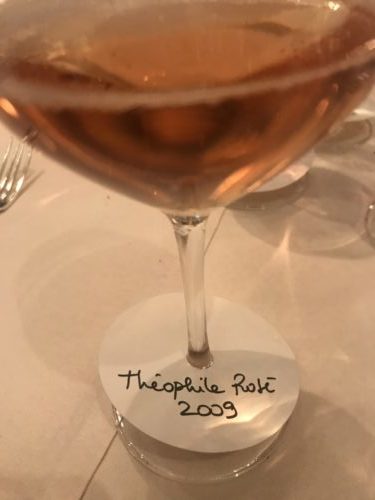
An excellent rosé Champagne
Hats off to the fine cuisine of chef Nicolas Baumann and owner Michel Rostang. As this article goes to press, in the midst of the Coronavirus lockdown here in France, let us ponder another notable Champagne quote, from Lily Bollinger, former manager of Champagne Bollinger:
“I only drink champagne when I’m happy, and when I’m sad. Sometimes I drink it when I’m alone. When I have company, I consider it obligatory. I trifle with it if I am not hungry and drink it when I am. Otherwise I never touch it—unless I’m thirsty.”
Here’s to Champagne when we can be less socially distant 😉.
 Wine Chronicles
Wine Chronicles
Hi Panos,
Please read here: https://www.greatbordeauxwines.com/chateau-profiles/sauternes-barsac/gilette
Xavier Gonet has an uncle in Pessac-Leognan, Michel Gonet (Ch. Haut Bacalan and Chateaux d’Eck. Michel Gonet produces a champagne of excellent quality too.